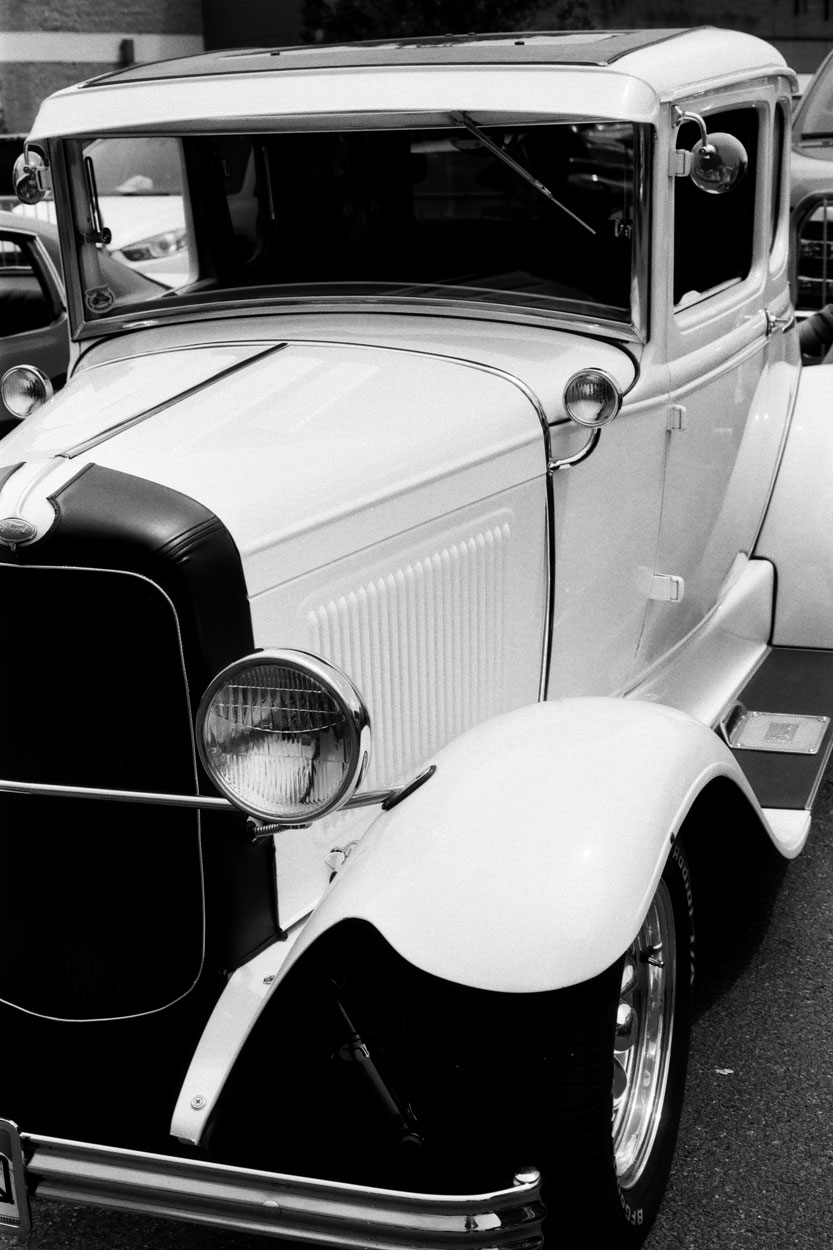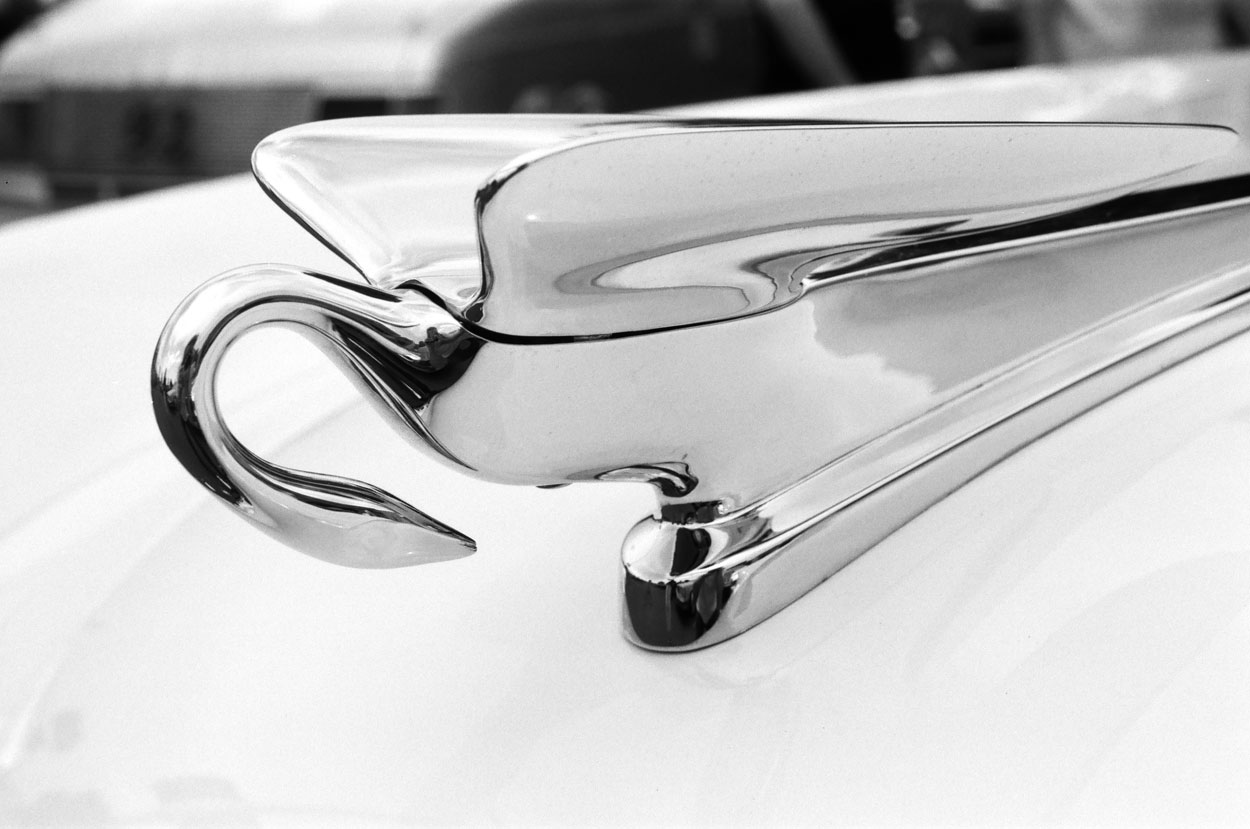Today’s Post by Joe Farace
Earl Grey tea is named after Charles, the 2nd Earl Grey who was the British Prime Minister from 1830 to 1834.
Last summer, the Rocky Mountain La-la-Palooza Show and Shine/Cruise-In was held in Broomfield, Colorado. The event was cut short by threatening thunderstorms with half-inch hail predicted so some people boogied a little early. While space on the shopping center parking lot was provided for 200 cars, it looked like only half that number showed up, probably because of the weather forecast.
 Mary dusted off her Beetle convertible and we made the 30-mile trek to Broomfield. I grabbed a Canon A-1 with my FD 50mm f/3.5 macro lens because as a family-style event with lots of activities for kids, La-la-Palooza was sure to be crowded—it was—and I expected to be limited to photographing parts of cars.
Mary dusted off her Beetle convertible and we made the 30-mile trek to Broomfield. I grabbed a Canon A-1 with my FD 50mm f/3.5 macro lens because as a family-style event with lots of activities for kids, La-la-Palooza was sure to be crowded—it was—and I expected to be limited to photographing parts of cars.
So what film did I choose? It was a 36-exposure roll of Lomography’s Earl Grey 100 film that I bought from Blue Moon Camera. Right now I’m awaiting the imminent receipt of a roll (each) of Lomo’s Potsdam and Berlin black and white films that are part of their Analogue Quartet. Look for a review of all four films, including the two color films that are part of the Quartet as soon as the weather improves, even just a little.
Earl Grey is an ISO 100 black and white, panchromatic negative film that, according to Blue Moon Camera, is comparable and “possibly the exact same as” Fomapan 100 or Kentmere 100. I have some Fomapan in the fridge, so maybe sometime in the future, ‘ll be able to see if that’s true. Instead of being a panchromatic film, my experience shows that Earl Grey leans into being an orthochromatic film (see blow)hat makes it ideal for capturing a strong graphic image like the black and white hot rod shown at right
Loading the film* was more of a challenge than Lomo’s Redscale XR film that I tested because the leader was shorter than normal (or standard) and the tip was cut on an odd angle that went through one of the sprocket holes. That made it difficult to load evenly onto the A-1’s take-up reel so I ultimately gave up trying to make it look nice and in the process ended up loading more film than necessary, resulting in only obtaining 35 frames from the roll. But I found our why.. One of the images was double exposed but it was in register and none of the succeeding frames overlapped. This indicates a camera problem and one I hadn’t had before or since. The Canon A-1 has double exposure capability, so maybe I accidentally triggered it. User error. Or did the equipment fail? Since it’s a poor workman who blames his tools, I’ll take responsibility.
 For a 100 ISO film, Earl Grey is grainy and had I realized that it would not have been my first choice for photographing cars‚ unless I was trying for a certain vintage film look. I was not.
For a 100 ISO film, Earl Grey is grainy and had I realized that it would not have been my first choice for photographing cars‚ unless I was trying for a certain vintage film look. I was not.
My choice of lenses bit me the butt too. The hood ornament at left belonged to a beautifully restored classic ivory Packard convertible but the 30-degree field-of-view of a 50mm lens along with where and how the car was parked, it was difficult to make a full length photograph of this lovely automobile. But since that 50mm lens is a macro lens, I decided to shoot a close-up of it’s iconic Cormorant hood ornament.
Mary and I hope to return to La-la-Palooza this year. Will I be bringing Earl Grey film and my Canon A-1? As Winston Churchill once said, “To improve is to change; to be perfect is to change often.” And so I probably won’t. Next year my film will likely be color negative, hopefully Kodak Gold 200; I love this film. It’s palette is perfect for classic cars and hot rods. Lens-wise, I like the flexibility of a zoom lens for car shows.
*Here’s alternative way of loading your film: Start by not putting the film cassette in the normal place; instead while holding the cassette in your left hand, insert the film leader into the take-up spool and advance the film until it’s secure. Then drag the cassette across the back of the camera dropping it in it into its standard location. Close the camera back and proceed as normal. Sounds easy but since it’s backward from standard this method takes some practice.
If you would like to send me any kind of other film to review or any other stuff that could be used for these posts or my videos on my YouTube channel you can mail it to: Joe Farace, PO BOX 2081, PARKER, CO 80134